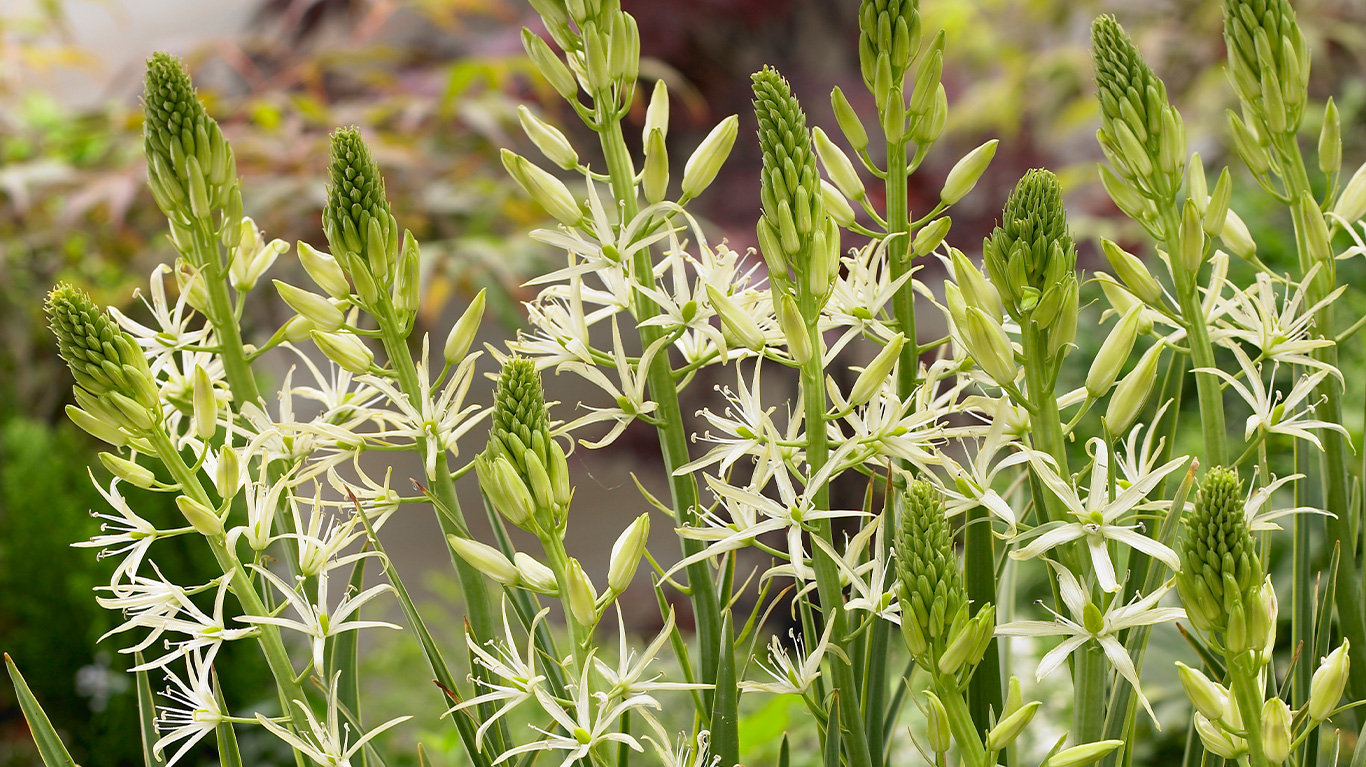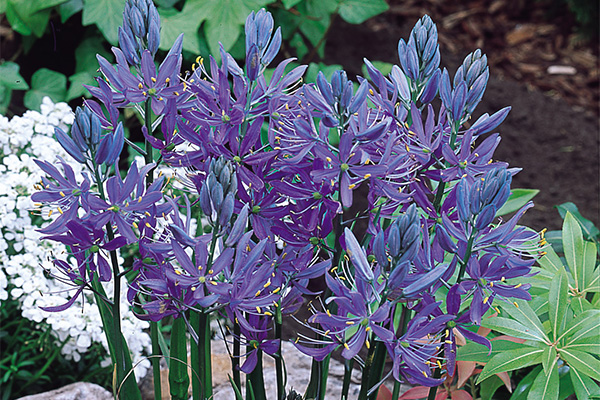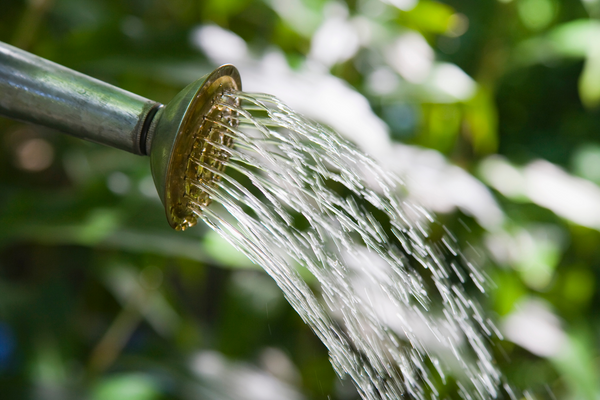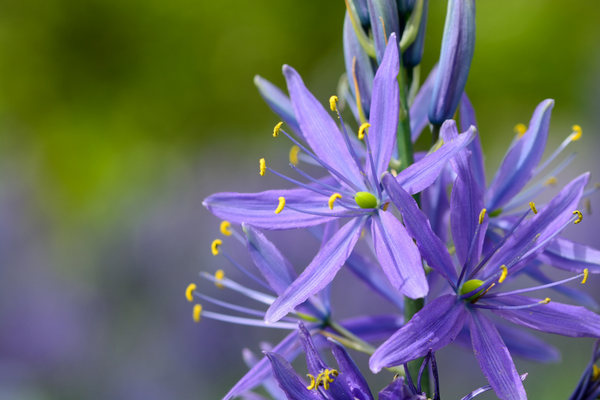
How Supplied
Our bulbs will be delivered fresh and healthy. There should be firm, not soft. Some bulbs may arrive with slight mould patches, but this is completely normal and can be brushed off. If you suspect that your bulbs are faulty, do not hesitate to get in touch.
Once your bulbs arrive, take them out of their packaging (including bags) and lay them out on newspaper so they can breathe. This is so they don’t excessively sweat in their containers, ruining the bulbs. Leave somewhere cool and dry until it’s time to plant them.
What We've Included
When to Plant | How to Plant | Where to Plant | After Care |
Common Issues | When will they Flower | Further Reading
When to Plant
Our bulbs will be delivered to you fresh and healthy. They should be firm, not soft. Some bulbs may arrive with slight mould patches, but this is completely normal and can be brushed off. If you suspect that your bulbs or corms are faulty, do not hesitate to get in touch.
Camassia bulbs can be planted outside from September to December giving you lots of time to get them in the ground.

How to Plant
To see the best results with your Camassia bulbs, follow these easy-to-follow planting instructions.
Borders
1. Dig a hole that’s wide enough to fit the bulb comfortably and at least 10-15cm deep.
2. Space each bulb apart by around 10cm.
3. Pop each bulb into their holes, pointed side up.
4. Cover with soil and pat down. Water if the soil is dry
Containers
1. Pick a large pot and fill it with any multi-purpose compost. Ensure there’s about 10-15cm between the bulb and the top of the soil.
2. Place your bulbs on top of the soil, about 7-10cm apart.
3. Cover with the compost to the top of the pot. Break up any lumps as you go.
4. Gently press the soil so that it’s nice and flat.
5. You can place your pot on feet to allow the moisture from the pot to escape more freely.
In Grass
Smaller Camassia such as Camassia esculenta (quamash) are perfect for growing in lawns and grassy areas. When left to grow, they will multiply, making them a perfect choice!
For a natural-looking growth, grab a handful of bulbs and throw them onto the area where you’d like to grow them and plant them where they land.
Plant as you would in beds and containers – Bulb pointy side up, 30cm deep to anchor them in place. Best to leave them and their foliage to fully die back before cutting them down, so avoid planting them in areas that often need a good going over with the lawn mower out as soon as the sun peeks out.
Where to Plant
To truly get the most from your bulbs, plant in beds, containers, and lawns. Camassia prefer to be left to their own devices and naturalise effortlessly, so they do prefer a flower bed or lawn over a container (although you can grow them in containers!).
Position them in moist, well-drained soil in areas that reach plenty of sunlight – whether it be full sun or partial shade. If you worry about a lack of sunlight exposure in your garden, flowerpots can be incredibly helpful. Simply move them to wherever the sun is positioned!

After Care
When to water
If the soil is moist, there’s no need to water these flowers too often. As the spring season in Britain is usually quite damp, the rain will water them for you!
If we’re having an abnormally dry season, especially during the summer, then you can water them once the soil feels dry but be careful not to waterlog the soil as it will ruin the bulbs.
What to do once they’ve finished blooming
Leave the blooms to fully die back before cutting. This will allow the bulb to soak up enough energy for the following year, helping it to grow into a healthy new bloom.
Storing Tips
As Camassia naturalise when left to their own devices, you may want to eventually separate the clumps that form in July or August and replant them elsewhere or store them until autumn.
1. Wait until the plant has died down and has reached a straw colour (often yellow).
2. Dig up the area they’re planted gently. Try not to damage the bulbs in the process.
3. Brush off any remnants of soil and dirt gently and divide them.
4. Leave to dry on a tray for 24 hours before storing so they don’t grow mould and rot. Store in a cool dry room until ready to replant in September. If you prefer, you could also simply add a layer of mulch over them after cutting them back in autumn to protect them from frosts.
Deadheading
Deadheading can help redirect the bulb’s energy into creating a new flower once the other one has wilted. It also helps to keep the flower bed looking tidy and uniform whilst the others are still in bloom. Simply cut the spent flower with clean shears, just above the leaves.
Common Issues and How to Solve Them

Not enough moisture in the soil
Camassia plants are quite low maintenance. There’s only a couple of reasons why they’re struggling to flower – one of them being that there isn’t enough moisture in their soil. This is an easy remedy.
Just give them a long drink of water each week, allowing it to soak the roots. This is much better than small douses here and there as that might not penetrate more than just the top layer.
Overcrowded Bulbs
Camassia will naturalise, growing more and more baby bulbs each year. If they’re left for too long, they might struggle to grow. In the summer once they’ve finished flowering and died back, lift the bulbs and divide them, replanting them elsewhere in the garden.
When will they Flower?
Camassia is a perfect late Spring flower, providing you with several months of glorious colour and interest. When you plant their bulbs in mid-late Autumn, you can expect to see Camassia appear in April to June.

Want to Know even more about Camassia?
Take a look at our helpful blogs

